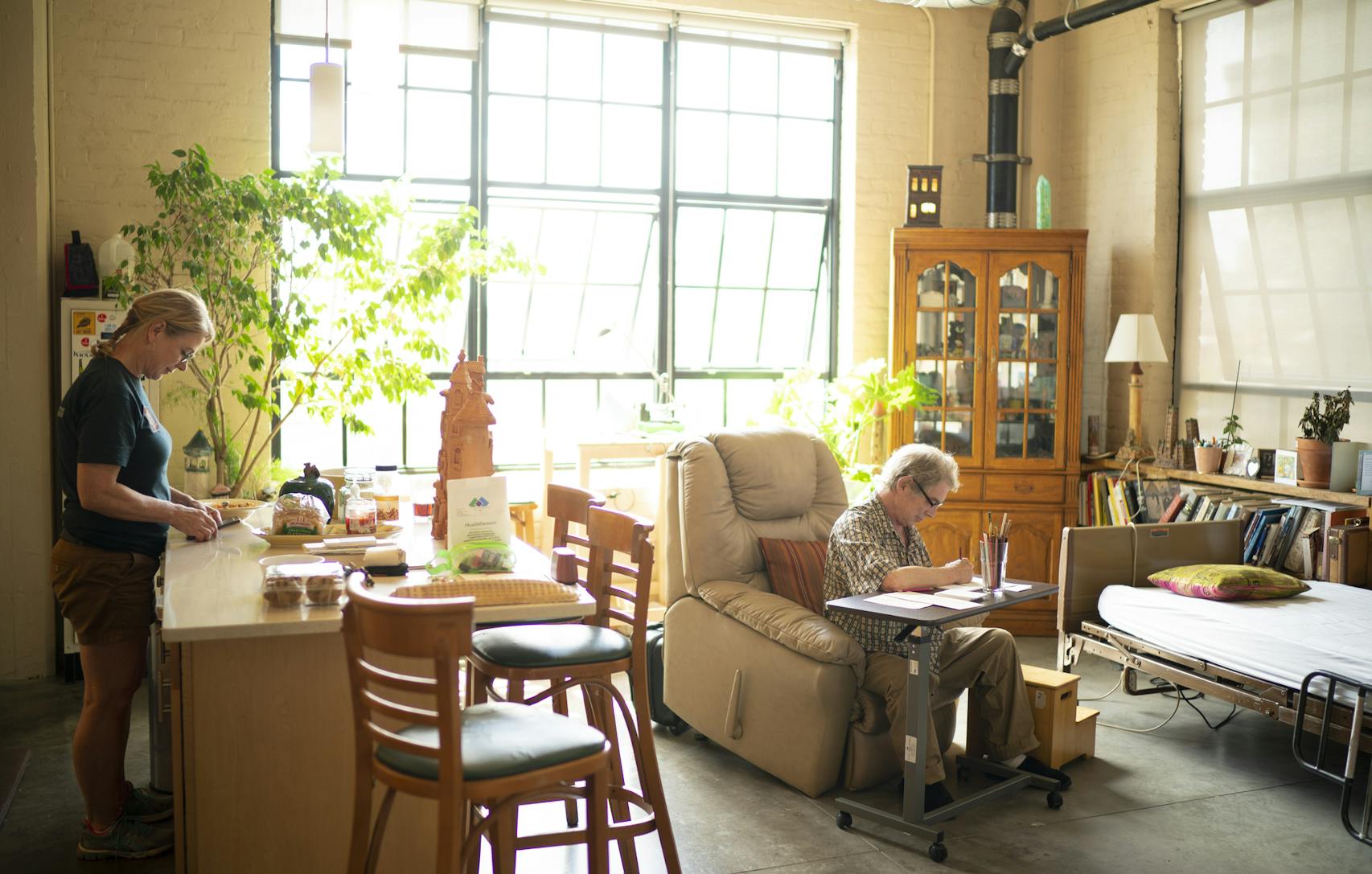A fixture of the Minneapolis art scene for nearly five decades, Aldo Moroni is known for making small-scale "mock civilizations" out of clay. These days, he's also making his own teeth. When he smiles, there's a single white strip of hardened material where his front teeth used to be.
"They served their purpose," he said in a thick Chicago accent. "What else do I need? Spend $2,000 on a pair of teeth before you get fried? You could give that money to your kids."
At 67, Moroni is dying of pancreatic cancer. He got the Stage Four diagnosis last September, shortly after he hired photographer Lisa Roy to help with his social media.
As Moroni got sicker, Roy's job expanded to apprentice, studio caretaker and legacy builder. She's learned how to make miniature buildings Moroni-style, as the artist tries to see through his final project, "M.EX. — Mesoamerican Experience," representing all the civilizations of Mesoamerica (Olmec, Maya, Toltec, Mixtec, Aztec) through Spanish imperialism to present-day Mexico.
Moroni envisioned the creation — and eventual destruction — of "ME.X." on an 11- by 20-foot mountainous landscape he built on a tabletop in his studio.
But a blood clot in his leg left him housebound. He's unable to climb onto the model. He might scale back the project so he can finish it. His assistant could carry out his plans. Or the work might transform into a social art project he calls "Blind Cortez," with the community picking up where he left off.
"He needed helpers and hands," said Roy. "It's not like we had a conversation: 'Now I want you to do this.' He's a great artist, right, so why not absorb anything you can?"
On a recent sunny afternoon, the artist sat perched in a chair on his sixth-floor artist loft in the Pillsbury A-Mill, with a postcard-esque view of the Mississippi River and the Gold Medal Flour building behind him, and a pack of Pall Malls in his shirt pocket. The apartment smelled faintly of cigarette smoke.
"Pall Malls are $7. They're cheap. I'm a pure addict," he said. "If you're gonna be obnoxious, be really obnoxious."
In the living room, next to a few bookshelves, a hospital bed was set up. "I'm gonna die in this room," he said.
His ex-wife, Kim Moroni, organized some snacks for him; she is one of his primary caretakers during these end-of-life, in-home-hospice days.
On the kitchen counter, several new orange-tinted terra cotta towers rested on their sides.
"It looks like it should be a cookie," he said.
Freshly molded, the towers still needed to be baked in the kiln that's a fixture of Moroni's California Building studio, located a couple of miles away.
"I'll sneak away from here and just make these," he said, grinning. "Don't tell."
A passion since age 4
Born in Chicago, he has called Minnesota home since coming to the Minneapolis College of Art and Design nearly 50 years ago. It was there, just a year before he graduated in 1976, that longtime MCAD professor Ari Munzner suggested that Moroni go back to making what he loved when he was 4 years old — miniature buildings.
"I made houses because I lived in Chicago and that's all I knew," said Moroni.
With Munzner's encouragement, he built 1,000 houses in just a month. Walker Art Center director Martin Friedman noticed his work, and put him in the 1977 exhibition "Scale and Environment, Ten Sculptors." Suddenly his art was in the company of such heroes as Charles Simonds and Siah Armajani.
Moroni uses tiny clay buildings to comment on humanity's relationship with the constructed world. His style is synonymous with the 1970s Italian arte povera movement — literally "poor art," it employed nontraditional, commonplace materials.
Creating and destroying miniature civilizations became Moroni's thing. Over his storied career, he has won three McKnight Foundation fellowships.
One of his most epic projects was the ritualistic building and destroying of Babylon over the course of several years. The Tower of Babel still stands in his studio.
In 2010, he created "Fragilearth" out of wet clay, documenting and livestreaming the entire creation. In the end, he played the role of nature, wiping out this imagined world.
That's what he envisions, too, for his final work, which for now exists as a limited-edition art book, "The Synoptic Codex of Mesoamerica," a collaboration with Justine Tucker that is for sale on his website, AldoMoroniStudios.com.
A historian who is always political in his work, Moroni said he was drawn to Mesoamerican history in a roundabout way when he learned that President Donald Trump "started putting babies in cages."
Facing a final 'confrontation'
His loft is another built environment, albeit far more personal.
Artwork from friends covers what he jokes is his "Wall of Shame," facing the big windows of the former Pillsbury flour mill. His current favorite is a black cross with Trump's head that a friend brought back from Cuba.
The wall along the entrance hallway is packed with photographs of his family in Chicago and Minneapolis. The fourth of nine kids from a big Italian-American family, he has six kids and two ex-wives.
There's a black-and-white photo of his grandfather, Harry, wearing black-rimmed glasses and a suit. His real name was Encino, and he immigrated to Chicago from a village near Luca, in Tuscany, shortly after World War I.
In 1920, Harry and a friend opened the Corona Café, a speakeasy on downtown Chicago's Rush Street that became a watering hole for politicians, writers and cabbies alike. Moroni grew up in the cafe and vividly remembers the tall buildings that surrounded it.
He visited his grandfather's hometown for six weeks in 1991 when he won a Jerome Foundation Travel Study Grant.
"It was surreal," he said. "The people looked like me — that's freaky."
He regrets not making that journey again, but memories from that trip still fuel his art. In one corner of his apartment, there's a lamp with a leaning-tower-like building that looks reminiscent of the Italian countryside.
"My daughter Maxamillia didn't have any lamps," he said. So he became a lampmaker, too.
These days, Moroni is drawing buildings on paper and hoping to get back to the studio, but he's also facing death head-on.
"When you come to that confrontation, which everyone does, some folks fight and fight, they have a lot of self-value and a lot for need for that," he said. "I don't, because mine is right here. ... It comes from the people around me as I go through this, so there's nothing to be worried or afraid of — this is where you're supposed to be.
"Sometimes it's not a fight, it's a process."
612-673-4437 • @AliciaEler

Yuen: Why do people forgive? It's messy, complex and 'the best form of self-interest'
How the Goo Goo Dolls learned the music biz from Minneapolis bands


